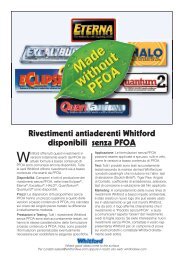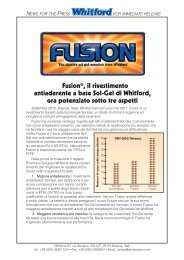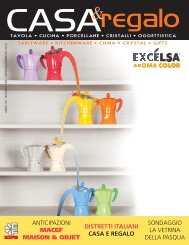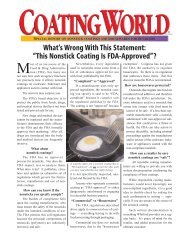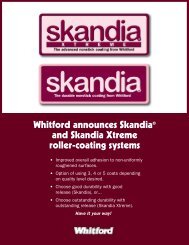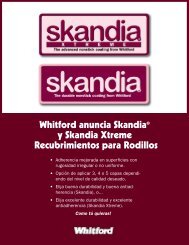Getting Started with Xylan - Whitford Corp
Getting Started with Xylan - Whitford Corp
Getting Started with Xylan - Whitford Corp
- No tags were found...
Create successful ePaper yourself
Turn your PDF publications into a flip-book with our unique Google optimized e-Paper software.
Mixing...Spraying...Curing...Testing...<strong>Getting</strong> started <strong>with</strong>Applying fluoropolymer coatings is not unreasonablycomplicated. Yet, there are many opportunities forerror — pitfalls that can lead to what is perceived as“coating failure” but in fact is due to common mistakesin processing.This document helps avoid these mistakes.Makers of the largest, most complete line of fluoropolymer coatings in the world
1. Choose the proper solventIf <strong>Xylan</strong> is “paint” and the paint store sells “paint thinner”, then shouldn’t that workjust fine? The answer is No.There are many different chemicals used to reduce coatings and to clean up aftertheir application. Most of these are not available at your local paint store.Every <strong>Xylan</strong> coating has been chemically crafted to achieve specific performancecharacteristics. And <strong>Whitford</strong> has a special solvent designed for maximum efficiency<strong>with</strong> each coating. <strong>Whitford</strong> publishes Product Data Sheets that specify the correctsolvent as well as the ideal reduction ratio. Paying attention to this at the outsetavoids serious problems later.2. Don’t get mixed up about mixingAll <strong>Xylan</strong> coatings must be properly mixed to provide maximum performance. Butnot all <strong>Xylan</strong> coatings can be mixed the same way. Some must be mixed vigorously<strong>with</strong> a high-shear blade, which actually “cuts”the coating into smaller and smaller bits, ultimatelydispersing it to fine particles. Other<strong>Xylan</strong> coatings (such as PTFE-heavy topcoats)must be rolled slowly (or they will coagulate andbe rendered useless). Roll for 1 hour at 30-40rpm. Check the bottom to ensure that no sedimentremains after mixing.Improper mixing is probably the mostcommon mistake made in the applicationof <strong>Xylan</strong> coatings.<strong>Whitford</strong> recommends using an air mixer <strong>with</strong>a high-speed dispersion blade for most <strong>Xylan</strong>coatings. This equipment can be purchasedthrough INDCO, (800) 942-4383, or Fawcett Co.,(330) 659-4187. INDCO also sells rollingmachines that are suitable for shear-sensitive coatings. Avoid mixing too fast, whichcan entrap air. Note: Paddle-type mixing blades are useful for keeping a coatingmixed once it has been dispersed <strong>with</strong> a high-shear blade, as are five-gallon paintshakers (also available from INDCO). But use these only <strong>with</strong> non-shear-sensitivecoatings. Check <strong>Whitford</strong>’s Product Data Sheets for proper mixing instructions.3. Think before you sprayProtect yourself <strong>with</strong> the proper safety equipment. Wear a respirator <strong>with</strong> a carbonfilter. Use a full face shield. Put on safety gloves. All these items are availablethrough Air Gas Direct Industrial, IPCO Safety Division, (800) 827-2338 in PA, (800)678-2878 in CA and (800) 445-3711 in GA.4. Select the right spray booth and gunMost regular and HVLP (High Volume, Low Pressure) spray guns work well. Butmake sure you have the proper fluid nozzle and air cap that correspond to the idealspraying viscosity of the coating (found in the Product Data Sheet).The booth must comply <strong>with</strong> the proper permits to meet local fire and safety regu-
lations. Two reliable suppliers of spray guns and booths are A.O.M.-America, LLC,(800) 533-6254 and ITW DeVilbiss, (419) 891-8191.5. Look before you leap<strong>Whitford</strong> recommends that you test the viscosity, the nozzle and the spray patternbefore you actually spray the part. Spray a thin aluminum test panel, which curesquickly, letting you check for smoothness and film thickness. If there are any problems,it’s better to discover them on a throwaway panel rather than on a part. If youhave any questions regarding the test results, you can always send the panel to<strong>Whitford</strong> so that our technicians can check it for you (see address at end). Panels areavailable through Q Panel Lab Products, (440) 835-8700.6. Prepare the part properlyAll <strong>Xylan</strong> industrial coatings requirethat the surface be properly prepared.First, any oils and contaminates must beremoved by degreasing the part <strong>with</strong> agood degreaser (such as an alkalinecleaner), or the coating will not adhere.Alkaline washing cleans parts <strong>with</strong> moderateor high pH cleaners. This is preferredfor high volumes of parts. Partswhich should not be washed by thismethod are those which may be adverselyaffected by the chemistry involved. Ifthe part can <strong>with</strong>stand elevated temperatures(800˚F/425˚C), burn off any contaminants.Grit-blasting <strong>with</strong> aluminum oxide or otherabrasives is a common cleaning technique,<strong>Whitford</strong> has developed a series of testmethods to help assure consistent and idealperformance for <strong>Xylan</strong> coatings. Copies areavailable to those who would like one.preferred for parts whose surface contaminants — rust, scale, corrosion, old coatings— must be removed physically. <strong>Whitford</strong> recommends a grit medium from 60- to 120-mesh/250- to 125 microns. Two suppliers of grit-blasting equipment are EmpireAbrasive Equipment Co., (215) 752-8800 and Georg Fischer - Disa Goff <strong>Corp</strong>., (405)382-6900. Blow off part <strong>with</strong> compressed air to remove any abrasive residue.Phosphating is a secondary surface preparation for steel which is generally usedafter degreasing, alkaline washing or grit-blasting. <strong>Whitford</strong> recommends a modifiedzinc phosphate <strong>with</strong> a fine crystalline structure such as Aerocote 4. A thin layer (750-1000 mg/ft 2 or 7.5-10 gm/m 2 ) of zinc phosphate is deposited on the surface of thepart to promote better adhesion and dramatically increase corrosion and chemicalresistance. Cleaning and phosphating solutions are available from Aerocote <strong>Corp</strong>.,(713) 224-6185.7. Cure the part correctlyAll <strong>Xylan</strong> coatings must be cured at a specific temperature to provide maximumperformance. Details of the cure are in the Product Data Sheet. Please note that the
proper cure temperature is the temperature of the part itself, not the temperaturereached inside the oven. <strong>Whitford</strong> recommends using a hand-held thermocouple tocheck the temperature (available through Omega Engineering Co., [800] 826-6342).Note: Always use an oven rated for the solventload of the coating to prevent explosions. Ovensuppliers: The Grieve <strong>Corp</strong>., (847) 546-8225, DespatchIndustries, Inc., (612) 781-5363, Lindberg Blue M,(800) 873-4468, and LTG Technology, (414) 672-7700.A simple, inexpensive Zahn cup anda stopwatch are perfect for checkingthe viscosity of <strong>Xylan</strong> coatings.8. Test to be sure<strong>Whitford</strong> recommends that any serious coatingapplicator have the basic testing equipment toassure ideal quality. This includes Zahn cups (tomeasure viscosity), a film-thickness gauge, a crosshatchcutter and special tape (to test adhesion), andvisual anchor profile comparators (to check grit-blastand phosphate profiles). Such equipment is availablethrough Paul N. Gardner Co. Inc, (954) 946-9454 and KTA-Tator, Inc., (412) 788-1300.9. Help is at handHaving the right equipment, following the proper procedures closely and testing tobe sure will help guarantee that all <strong>Xylan</strong> coatings you apply perform as expected.Note: Remember to use the specific Product Data Sheet for each coating you apply.<strong>Whitford</strong> offers additional literature to help <strong>with</strong> the process:1. “Engineering Design Guide” (36 pages of technical information on the applicationand use of fluoropolymer coatings).2. “9 Misconceptions about <strong>Xylan</strong> Coatings” (9 common mistakes).3. “Fastener-Class Coatings” (which <strong>Xylan</strong> coatings to use for fasteners).4. “1021 Bulletin” (comprehensive introduction to the <strong>Xylan</strong> 1000 Series coatings).5. “1000 Series Cure Chart” (how curing temperatures affect coating properties).6. “Solving Common Coating Problems” (Wall chart <strong>with</strong> visual and verbal identificationof common problems and how to solve them).7. “<strong>Whitford</strong> Test Methods and Procedures” (explained and illustrated).If you have any questions, or would like any of this literature, please contact us at<strong>Whitford</strong> <strong>Corp</strong>., Box 80, Elverson, PA 19520. Tel: (610) 286-3500. Fax: (610) 286-3510.Email: sales@whitfordww.com. Web: whitfordww.com.NON-WARRANTY: THE INFORMATION PRESENTED IN THIS PUBLICATION IS BASED UPON THE RESEARCH AND EXPERIENCE OF WHITFORD. NO REPRE-SENTATION OR WARRANTY IS MADE, HOWEVER, CONCERNING THE ACCURACY OR COMPLETENESS OF THE INFORMATIONPRE SENTED IN THIS PUBLICATION. WHITFORD MAKES NO WARRANTY OR REPRESENTATION OF ANY KIND, EXPRESS OR IMPLIED, INCLUDING WITHOUTLIMITATION ANY WARRANTY OF MERCHANTABILITY OR FITNESS FOR ANY PARTICULAR PURPOSE, AND NO WARRANTY OR REPRESENTATION SHALL BEIMPLIED BY LAW OR OTHERWISE. ANY PRODUCTS SOLD BY WHITFORD ARE NOT WARRANTED AS SUITABLE FOR ANY PARTICULAR PURPOSE TO THEBUYER. THE SUITABILITY OF ANY PRODUCTS FOR ANY PURPOSE PARTICULAR TO THE BUYER IS FOR THE BUYER TO DETERMINE. WHITFORD ASSUMESNO RESPONSIBILITY FOR THE SELECTION OF PRODUCTS SUITABLE TO THE PARTICULAR PURPOSES OF ANY PARTICULAR BUYER. WHITFORD SHALL INNO EVENT BE LIABLE FOR ANY SPECIAL, INCIDENTAL OR CONSEQUENTIAL DAMAGES.<strong>Xylan</strong> is a registered trademark of <strong>Whitford</strong> © <strong>Whitford</strong>/10/10.



